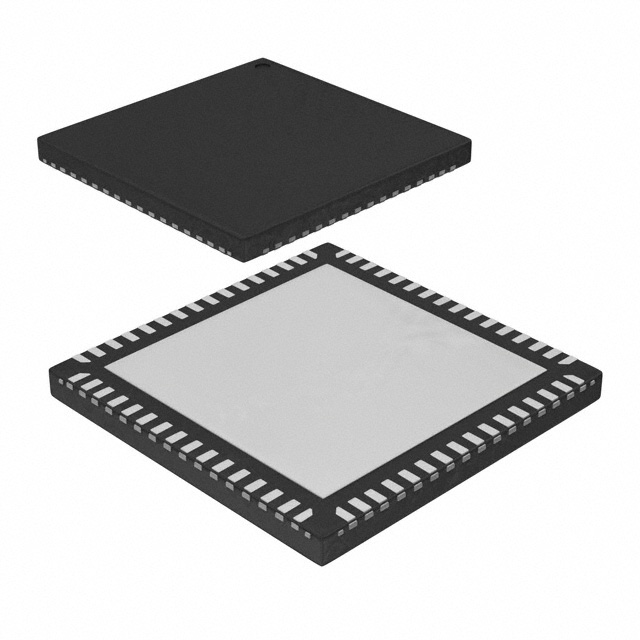Consulte las especificaciones para obtener detalles del producto.

ATMEGA64L-8MC
Product Overview
Category
ATMEGA64L-8MC belongs to the category of microcontrollers.
Use
It is commonly used in various electronic applications that require a microcontroller for processing and controlling tasks.
Characteristics
- Low-power consumption
- High-performance 8-bit AVR microcontroller
- 64KB Flash memory
- 2KB SRAM
- 32 general-purpose I/O lines
- 8-channel 10-bit ADC
- Multiple communication interfaces (UART, SPI, I2C)
- Operating voltage: 2.7V to 5.5V
Package
ATMEGA64L-8MC is available in a compact and convenient package.
Essence
The essence of ATMEGA64L-8MC lies in its ability to provide efficient and reliable control and processing capabilities in a wide range of electronic applications.
Packaging/Quantity
ATMEGA64L-8MC is typically packaged in trays or reels, with a quantity of 250 units per reel.
Specifications
- Microcontroller architecture: AVR
- Clock speed: 8 MHz
- Program memory size: 64KB
- Data RAM size: 2KB
- Number of I/O pins: 32
- Analog-to-Digital Converter (ADC): 8 channels, 10-bit resolution
- Communication interfaces: UART, SPI, I2C
- Operating voltage range: 2.7V to 5.5V
- Operating temperature range: -40°C to +85°C
Detailed Pin Configuration
The ATMEGA64L-8MC microcontroller has a total of 64 pins. The pin configuration is as follows:
- Pins 1 to 8: Port A (PA0 to PA7)
- Pins 9 to 16: Port C (PC0 to PC7)
- Pins 17 to 24: Port D (PD0 to PD7)
- Pins 25 to 32: Port E (PE0 to PE7)
- Pins 33 to 40: Port F (PF0 to PF7)
- Pins 41 to 48: Port G (PG0 to PG7)
- Pins 49 to 56: VCC, GND, AVCC, AREF, ADC6, ADC7, AGND, AREF
- Pins 57 to 64: XTAL1, XTAL2, RESET, VCC, GND, PORTB (PB0 to PB7)
Functional Features
1. Low-power Consumption
ATMEGA64L-8MC is designed to operate with low power consumption, making it suitable for battery-powered applications.
2. High-performance AVR Microcontroller
With an 8 MHz clock speed and a powerful architecture, ATMEGA64L-8MC offers high-performance capabilities for efficient data processing and control tasks.
3. Ample Memory Capacity
The microcontroller features 64KB of Flash memory for program storage and 2KB of SRAM for data storage, providing sufficient space for complex applications.
4. Versatile Communication Interfaces
ATMEGA64L-8MC supports multiple communication interfaces such as UART, SPI, and I2C, enabling seamless integration with other devices and peripherals.
5. Analog-to-Digital Conversion
Equipped with an 8-channel 10-bit ADC, the microcontroller allows for accurate analog signal conversion, expanding its range of applications.
Advantages and Disadvantages
Advantages
- Low-power consumption extends battery life in portable applications.
- Ample memory capacity enables the implementation of complex algorithms.
- Versatile communication interfaces facilitate connectivity with other devices.
- High-performance architecture ensures efficient data processing.
Disadvantages
- Limited clock speed compared to higher-end microcontrollers.
- 8-bit architecture may not be suitable for certain demanding applications.
Working Principles
ATMEGA64L-8MC operates based on the AVR architecture, which utilizes a Harvard architecture with separate program and data memories. The microcontroller executes instructions stored in its Flash memory, processes data using its registers and ALU, and communicates with external devices through its I/O pins and communication interfaces.
Detailed Application Field Plans
ATMEGA64L-8MC finds applications in various fields, including but not limited to: - Home automation systems - Industrial control systems - Robotics - Automotive electronics - Consumer electronics - Internet of Things (IoT) devices
Detailed and Complete Alternative Models
Some alternative models that offer similar functionalities to ATMEGA64L-8MC include: - ATMEGA128L-8MC - ATMEGA32L-8MC - ATMEGA2560-8MC - PIC18F4520 - STM32F103C8T6
Enumere 10 preguntas y respuestas comunes relacionadas con la aplicación de ATMEGA64L-8MC en soluciones técnicas
Sure! Here are 10 common questions and answers related to the application of ATMEGA64L-8MC in technical solutions:
Q: What is the ATMEGA64L-8MC microcontroller used for? A: The ATMEGA64L-8MC is a microcontroller commonly used in various technical solutions, such as embedded systems, robotics, industrial automation, and IoT devices.
Q: What is the clock speed of the ATMEGA64L-8MC? A: The ATMEGA64L-8MC operates at a clock speed of 8 MHz.
Q: How much flash memory does the ATMEGA64L-8MC have? A: The ATMEGA64L-8MC has 64 KB of flash memory, which can be used for storing program code.
Q: Can I expand the memory of the ATMEGA64L-8MC? A: No, the ATMEGA64L-8MC does not support external memory expansion. However, it does have 4 KB of internal SRAM for data storage.
Q: What peripherals are available on the ATMEGA64L-8MC? A: The ATMEGA64L-8MC includes various peripherals, such as UART, SPI, I2C, ADC, PWM, timers, and GPIO pins, which can be used for interfacing with other devices.
Q: Can I use the ATMEGA64L-8MC for real-time applications? A: Yes, the ATMEGA64L-8MC has built-in timers and interrupt capabilities, making it suitable for real-time applications that require precise timing and event handling.
Q: What voltage range does the ATMEGA64L-8MC operate on? A: The ATMEGA64L-8MC operates on a voltage range of 2.7V to 5.5V, making it compatible with a wide range of power supply options.
Q: Is the ATMEGA64L-8MC programmable in C/C++? A: Yes, the ATMEGA64L-8MC can be programmed using C/C++ programming languages, along with the appropriate development tools and compilers.
Q: Can I use the ATMEGA64L-8MC for low-power applications? A: Yes, the ATMEGA64L-8MC has various power-saving features, such as sleep modes and power reduction registers, which make it suitable for low-power applications.
Q: Are there any development boards available for the ATMEGA64L-8MC? A: Yes, there are several development boards available that feature the ATMEGA64L-8MC, such as Arduino Mega 2560, which provide an easy-to-use platform for prototyping and testing projects.
Please note that the specific details and answers may vary depending on the context and requirements of your technical solution.

